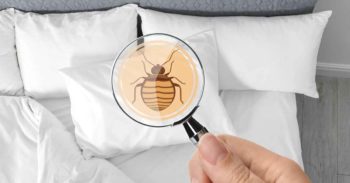
 Bed bugs have been difficult to treat for a long time – a very long time. Bed bugs are ancient insects that first preyed upon bats before eventually infesting human settlements.
Bed bugs have been difficult to treat for a long time – a very long time. Bed bugs are ancient insects that first preyed upon bats before eventually infesting human settlements.
Even the official name for bed bugs, Cimex lecturlarius, has its roots in an ancient culture. In ancient Rome “lecturlarius” referred to a bed or couch and “Cimex” meant “bug.” Bed bugs have been documented as infesting human communities for more than 200,000 years.
How Old Are Bed Bugs?
In addition to bothering the ancient Romans, mentions of bed bugs can be found in ancient Egyptian literature. But bed bugs are even older than that.
According to research from the University of Sheffield’s Department of Animal and Plant Sciences, which was published in a 2019 edition of the scientific journal, Current Biology; evidence shows that bed bugs co-existed with dinosaurs – which means they’re more than 100 million years old! That is much, much older than experts previously thought.
Since the first documented host for bed bugs was the bat, it was previously assumed that bed bugs were younger than bats (which are about 50 million years old). The study spent 15 years examining the DNA of 34 bed bug species and proving that bed bugs evolved long before bats.
Where Did Bed Bugs Originate?
It is believed that bed bugs originated in the Middle East. However, the University of Sheffield’s research study involved the exploration of deep caves in Southeast Asia, South America, Mexico, and Texas to find fossil evidence of bed bugs and trace its origins. Wherever bed bugs originated, they spread from there and that spread accelerated with the emergence of human civilization.
In the ancient world, Egyptians would drink a potion containing bed bugs to treat snake bites. Ancient Greeks and Romans would collect bed bugs and burn them to force leeches to let go and stop feeding. In 77 A.D., Roman philosopher Pliny wrote about using bed bugs to cure ear infections and other illnesses. Ancient Greek playwright Aristophanes mentioned bed bugs in his works, as does the Jewish Talmud.
Did Bed Bugs Feed on Dinosaurs?
No, they did not. Even though bed bugs co-existed with dinosaurs, experts say they would not have fed on dinosaurs. In nature, bed bugs seek out havens like bird nests, bat roosts, owl burrows, etc. – all-natural equivalents to human bedding that we know bed bugs love. Dinosaurs do not appear to have adopted a similar nesting practice, so they would not have been as attractive to bed bugs.
The University of Sheffield researchers are now trying to figure out what creatures were the ones bed bugs fed on before bats evolved. So far, bats are the oldest animal we have clear evidence of bed bugs infesting even though bed bugs evolved long before bats.
How Did Bed Bugs Spread Over Time?
Bed bugs spread as human communities spread before we had effective treatments for them. Heat from fires and cooking attracted bed bugs as did the blood they fed on from humans. Infesting clothing and bedding was an easy and convenient way for bed bugs to spread and feed everywhere from 100 A.D. Italy to 600 A.D. China and from 1200 A.D. Germany to 1400 A.D. France and more.
How Did Bed Bugs Come to America?
Most likely, bed bugs came to North America with colonists. While caves in Mexico and Texas were examined for historic evidence of bed bug species to date, experts can find no evidence of bed bugs being mentioned by or having words in any Native American language prior to the arrival of Europeans.
In addition to all the evidence of bed bugs in Europe, the Middle East, and Asia in the ancient world and beyond; England began reporting about bed bugs in the 1500s. Ship logs from the 1800s mentioning bed bugs also make it clear that these pests traveled to the Americas with European settlers.
Arrow Banishes Bed Bugs For Good
Bed bug infestations are difficult to treat. If you have been exposed to bed bugs, talk to the experts at Arrow Exterminating about confirming the exposure and how to treat it. Contact Arrow Exterminating today.




